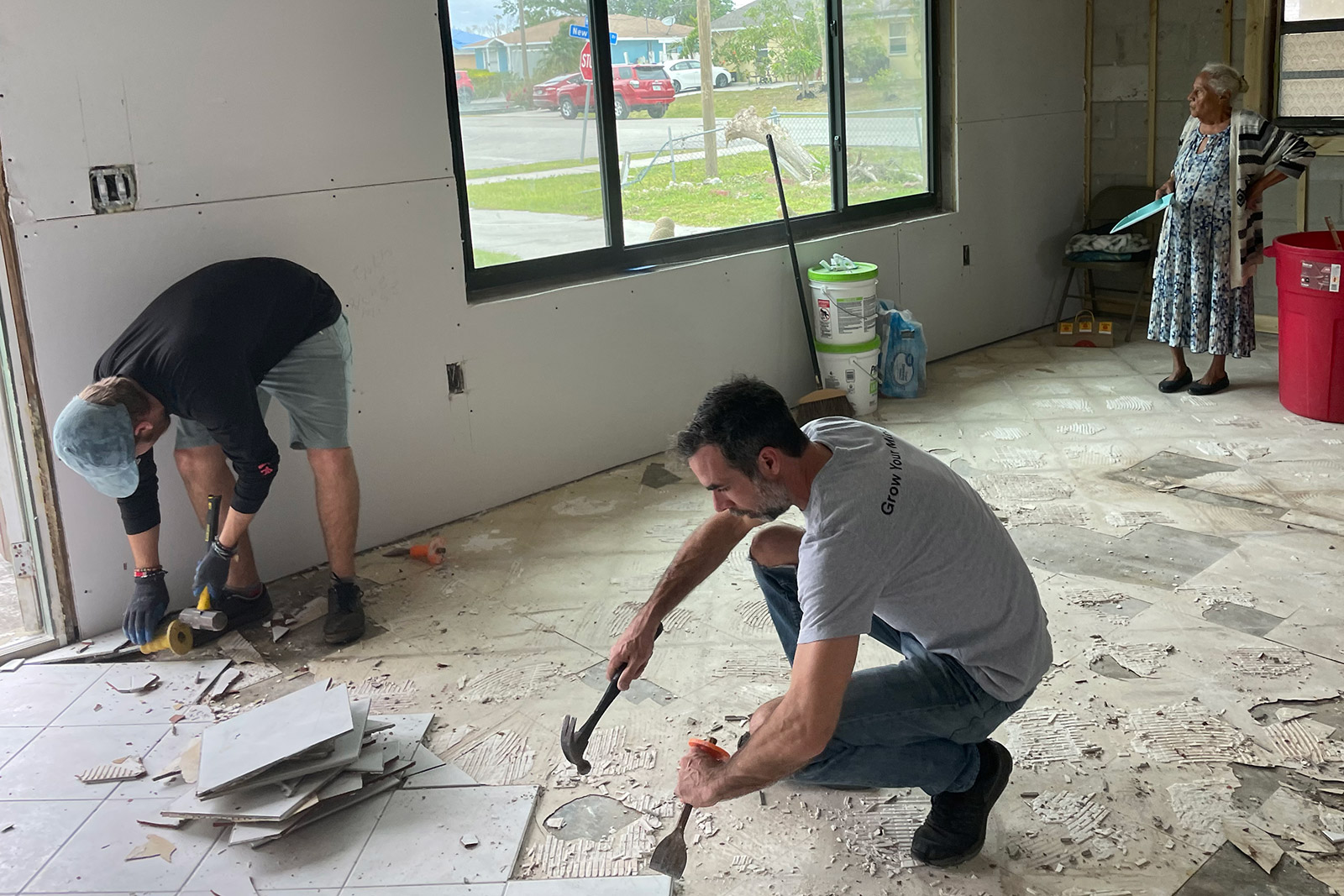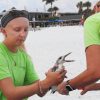“She was just the sweetest little old lady,” explains Eckerd College junior Tay Zilinskas, an animal studies student from Kissimmee, Florida. “She was about 80 years old, didn’t speak English, and lived in a poor neighborhood outside of Fort Myers. Her daughter was killed in the hurricane, and the storm wrecked her house.
“Now she has to raise her grandson by herself. She got minimal insurance money for the house, so they have to live with relatives. But she and her grandson showed up at the house every day to help rebuild. I removed tile and grout on the floor, and helped move Sheetrock. There was no electricity, and it was very hot. But everybody just continued to do what needed to be done.”
The woman’s name is Auria, and her grandson is Christopher.
“It’s taken six months, but most of the walls are up now,” Tay says. “And as soon as the water is hooked up, she wants to move back in. She just wants to be back in her home.”
Tay was describing her role as part of the Eckerd College Office of Service Learning’s Spring Break Service Program. Led by Ronald Porter ’05, Ph.D., director of service learning, the program this year offered service opportunities focused on local issues: Keep Pinellas Beautiful; Bees, Trees and Oysters; Food Security, Migration and Partnership; and Tay’s project—two Hurricane Ian relief trips to Fort Myers.
A powerful Category 5 hurricane with winds up to 160 mph, Ian made landfall September 28, 2022, about 120 miles south of the Tampa Bay area around Fort Myers. Before it crossed the state and entered the Atlantic, Ian would cause more than $65 billion in insured losses, making it the third costliest weather disaster in U.S. history, behind only hurricanes Katrina (2005) and Harvey (2017).
Ian also claimed the lives of at least 150 Floridians.
More than 35,000 homes were damaged or destroyed in the Fort Myers area. Half a year later, while most roads have been cleared and many structures repaired, hundreds of homes remain uninhabitable. That’s what prompted Adam Guerin, Ph.D., associate professor of history at Eckerd, to lead a group of eight students, including Tay, to Harlem Heights, a neighborhood just east of Fort Myers. When Guerin and his group returned to Eckerd after three days, Katarzyna Nowacki ’17, Eckerd’s Emergency Response Team coordinator, led another group of five Eckerd students to the same location.
Supervising the students’ work were members of Cypress Missions, a New Jersey–based nonprofit. “They’re retired contractors and people who have done construction work and know how to network,” Guerin explains. “After natural disasters, they go out to the sites and provide relief, usually to the working class neighborhoods.
“Where we went, every third house was in disrepair. The residents are mostly Latino immigrants. There was a lot of need. One woman whose house was destroyed got a $40,000 payout. That’s not going to go very far, but with free labor, you can get a lot of work done. We re-floored the entire house. Most of the students had some kind of basic experience, and then they just kind of learned on the job.
“There need to be thousands more trips like ours,” Guerin adds, “before the most vulnerable populations in Fort Myers are back on their feet.”

Clearing brush
About 708,000 insurance claims linked to Ian were filed in the wake of the storm, according to the Florida Office of Insurance Regulation. As of March, about 240,000 of those claims, or 34% of the total, were either rejected or remain unpaid. So even if a homeowner had insurance, there was no guarantee they would be awarded the money to rebuild.
Nic Silard, a sophomore environmental studies student from Annapolis, Maryland, says he saw that dilemma firsthand. “I was looking for something different to do over spring break, and I thought nothing could be better than helping with hurricane relief because it was so close to home,” he says. “That was supposed to happen to us here at Eckerd.
“We were on the highway going down there, and as we got close, you could see a lot of signs still mangled. And then the damage to the houses. One house would be pretty well repaired, but the next house was completely gutted.” Nic spent his time installing drywall and insulation at the home of the 80-year-old grandmother.
“It’s clear the people in that area are going to be recovering another six months,” Nic adds. “And maybe after that, too. Which makes me really grateful for everything we have. It’s eye-opening to see how quickly life can change for people. And how lucky we were. It’s really motivated me to take advantage of the opportunities I have here, and to give back as much as possible.”
Tay adds that it’s profoundly sad to think about how many homes are still severely damaged, and how much time has passed. “People have been out of their houses for six months,” she says. “I felt proud to know I was making a difference in someone’s life.
“That storm was supposed to hit Eckerd,” she adds. “It could have affected me. I would hope someone would do the same thing for me if we needed help to rebuild.”














